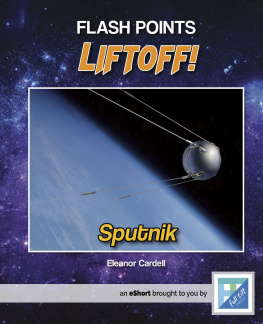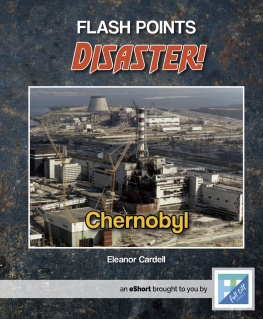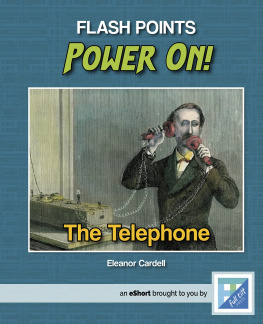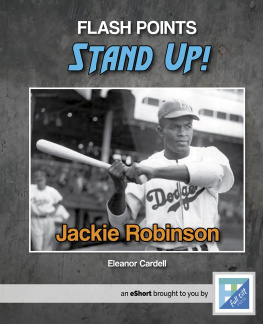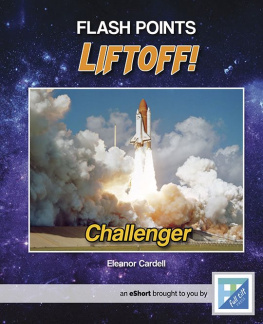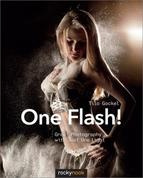

October 4, 1957
e fuel in the rocket starts to burn. It blasts o toward
space. Engineers wait to nd out if theyve succeeded.
en, a radio signal comes through, loud and clear. Russia,
known as the USSR, has successfully sent the rst manmade
object into orbit around Earth. It is called Sputnik .
e United States is shocked. Nobody thought the USSR would be
the rst to put a satellite into orbit . But people are also excited. ey
can use homemade radios to pick up Sputnik s signal as it ies overhead.
ey can watch it with binoculars, a spot of light in the sky.
Sputnik cant do very much. It is silver,
and about the size of a beach ball. It
has three antennae sticking out from
it. It weighs less than pounds (91
kilograms). All it can do is send radio
signals. But that is not whats important
about it. Sputnik is something
totally new.
Sputnik
engineer: someone who
designs and builds machines
satellite: a smaller object that
orbits a larger object in space
orbit: the path that something
follows as it travels
around something else
2 Flash Points

Sputnik orbited about miles
(579 kilometers) above Earth.
Did you know?
The USSR launched Sputnik
on November 3, 1957. It
carried a dog named Laika.
Liftoff!

Cold War
e year 1947 marked the beginning of the Cold
War. is was a time of fear and tension between
the US and the USSR. e two countries
were both trying to develop more powerful
technology. ey were especially interested in
rockets. ey needed rockets to re missiles.
A New Frontier
In the 1950s, the possibility
of exploring space was
an exciting new concept.
People thought of the
future when they thought
of space travel.
How and Why
Historical events rarely have only one simple cause. Many dierent
things such as certain events or changing ways of thinking work
together to shape the future. Take a moment to explore some of the things
that led to the launch of Sputnik .
4 Flash Points

Satellites
e USSR wanted to use a
satellite to send communication
signals. is would allow them
to talk from all over the world.
But rst they needed to put
a satellite into space. Many
scientists worked day and night.
ey needed to build a satellite
that worked. ey also needed a
rocket to put it into orbit.
Race to Space
In July 1955, the US made an
announcement: By the end
of 1958, they would launch a
satellite into space. e USSR
couldnt let them win. Less than
a week later, they also made an
announcement. e USSR said
that they would launch a satellite
very soon. e race to space
had begun.
Liftoff!

What Happened Next
e USSR didnt just launch a satellite into
space. It also launched the Space Race.
Before the launch of Sputnik , the
USSR and the US both wanted
to move science forward. ey
wanted to travel to space. At rst,
both countries mainly studied
rocket science. Nothing can be
sent into space without a rocket.
Aer a rocket was created, then
they could build things to put on
the rocket.
e Cold War was a very scary time.
e US was afraid of the USSR. Many
people thought the USSR would use their rockets
to re a missile at the US. e US had also been building new
rockets. However, they hadnt been as successful as the USSR. e
US needed to build better rockets if they wanted to catch up to
the USSR.
e US began to give more money to the military. ey wanted the
military to build rockets. ey also gave money to space programs.
ese programs would build satellites. But these groups did not work
together. e US realized that this needed to change. e next step
was to create an organization that was in charge of space science.
6 Flash Points

A model of Sputnik hangs in
the Smithsonian Institutes
National Air and Space
Museum, in Washington, D.C.
Did you know?
It took Sputnik minutes
to travel around Earth.
Liftoff!

Ripple Effects
A single event, no matter how big or small it may
seem at the time, can have a big impact on the future.
e launch of Sputnik had many farreaching eects.
Cause
for Concern
With the launch
of Sputnik , the USSR
proved that it could
send objects into space.
Countries around the world
were worried. Governments
began to spend more
money. A lot of this money
was spent on the military.
Many countries created
space programs as well.
Everyone wanted
to put satellites
into space.
NASA
In the US, many dierent groups
were working on space projects.
The US needed to bring those
groups together. The government
decided to do something. In July
1958, it founded the National
Aeronautics and Space
Administration (NASA).
8 Flash Points

Big
Changes
Sputnik s launch
caused big changes in
science. Many of these
changes were in computer
science. For example,
microelectronics were
built to be used in
satellites, rockets, and
spaceships. But today,
they are also used in
phones, computers,
TVs, and more.
Studying Science
The United States wanted
to catch up to the USSR. They
needed to teach kids science and

